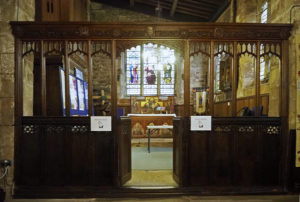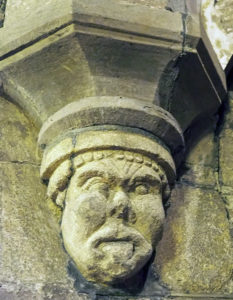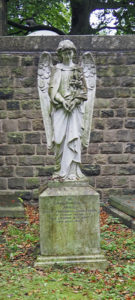You can’t miss Treeton Church. It stands on top of the scarp and is a well known landmark for drivers leaving the M1 and dropping down Sheffield Parkway into Sheffield. Its square tower dominates the small mining settlement around it.
There has been a church here since Saxon times and it is one of the few churches in South Yorkshire recorded in Domesday Book. Nothing remains of the Saxon church and the present building dates from the late C12th. It has been extended, altered and restored over the years. leading to what Nikolas Pevsner describes as “a confusing building”.
The church, apart from the top of the tower, is built from the local Rotherham Red Sandstone, which really does look red on a sunny day. The top of the tower was added later and was built from Magnesium Limestone, in marked contrast to the rest of the church.
The earliest part of the church is the nave and north aisle which were built in 1175, possibly on the earlier Saxon church. The chancel was built in the C13th along with the base of the tower, which was originally offset at the south west corner of the church. It only became part of the church building when the south aisle was completed in the C14th.
In the C15th, the nave was extended at the west end to line up with the tower. A south porch was built and the nave roof was raised with a clerestory added. The Brampton Chapel, at the east end of the south aisle dates from the C16th.
There was the usual restoration of the church in the Victorian times. The small child’s coffin now built into the west wall of the porch was found during work on the south wall in 1892, and was part of the original foundations of the wall. There was no lid and it was filled with dirt. It was a common pagan belief was that a new born child should be buried alive in the foundations of a new building. It is thought this tradition may have survived here but with an empty coffin. The other suggestion is that it was an old coffin that was recycled for use as building stone.
The plaster was scrapped off the inside of the church, leaving the bare stone walls so much beloved by the Victorian restorers. They also removed any wall paintings and tantalising traces survive on the north chancel arch and above the lintel of the window in the south aisle. They are tiny and you need where to look and also a torch to see them clearly!
All the woodwork and windows date from then and a vestry was added at the end of the north aisle. A new vestry was added to the side of the north aisle in 1973 and now serves as a small coffee lounge area.
It is an attractive church with a square nave with a green man carved on one of the beams, again only visible with a torch. The north arcade still has the C12th round arches and study octagonal pillars. The south arcade is late C13th with tall pointed arches with what are described as quatrefoil pillars which have a narrow band of carved acanthus leaves at the top.
The simple stone font is in line with the doorway into the church. The wood of the earlier pews has been used to panel the base of the walls. In the back south west corner is a C13th effigy, which is one of the oldest in South Yorkshire. This is now very eroded and any shield has been removed. It has been suggested that it was Sir Christopher Talbot who was the second son of the Earl of Shrewsbury and who was Lord of the manor of Treeton and lived at Sheffield Castle. That may explain the source of a story still common one hundred years ago that Treeton Grange and Sheffield CAstle, demolished after the Civil War, were connected by an underground passageway. One of the C16th pew ends in the south aisle has a carving of the Talbot hounds.
The narrow chancel arch has two squints on either side giving views of the high altar. Across is a wooden screen. The splendid carved marble font was donated by an owner of nearby Orgreave Colliery. Behind is a C13th coffin lid which was placed here during the C19th restorations.
There is a large organ on the south wall of the chancel. Beyond is a late C13th sedillia. On the opposite wall are two ambry cupboards with wooden doors.
The table altar has pre-Raphaelite style angels painted on the front. The small reredos on the east wall has the symbols of the four evangelists.
The Brampton Chapel is reached through another carved screen. The pews have been removed and it is now used as a meeting or exhibition area. The painted altar with triptych above are C19th. On the south wall is what is described as a Piata triptych. showing the Virgin Mary holding the dead body of Christ.
In the passageway leading to the small coffee lounge are two lead sheets, complete with plumbers marks, that were salvaged after the rest of the lead had been stolen from the church roof. In 2008, police found three youths on the church roof, wearing masks, balaclavas and gloves. Over £100,000 of lead had already been stolen in ten separate raids, but the youths were released without charge because they “might be there just for the view”.
This is very attractive church, set in the centre of the village and much loved by its congregation. It is open for coffee on Thursday mornings. It is usually open as part of the Heritage Open Doors.
The main entrance is off Front street although there is a small entrance off Church Lane. The post code is S60 5QP and the grid reference SK432 877. There are more pictures “here.”:http://wasleys.org.uk/eleanor/churches/england/yorkshire/south_yorkshire/treeton/index.html.
Disabled visitors need to be aware there is a step down into the church. The rest of the church is accessible although there are steps up to the high altar.










